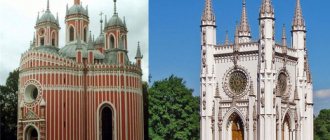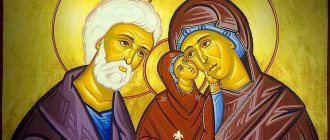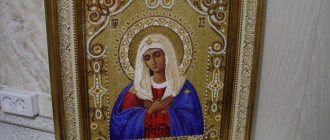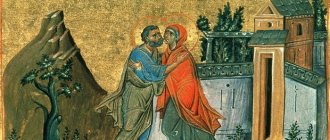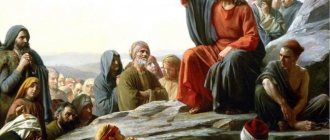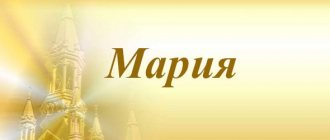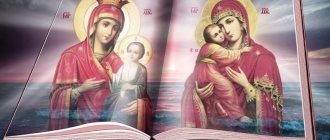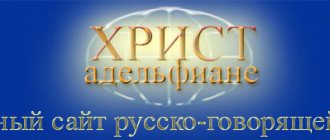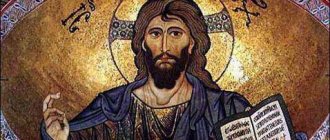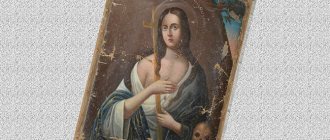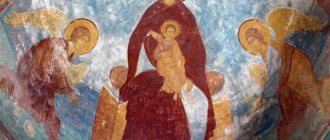Dogma of the Catholic Faith
Catholics fully and unconditionally believe that Christ was conceived without the participation of a man. That is, the original sin from the Mother of God was removed by God himself. However, the Catholic Church did not immediately come to accept this fact. The Immaculate Conception of the Blessed Virgin was accepted as a dogma on December 8, 1854 by Pope Pius the Ninth. And although another dogma “on the infallibility of the pope” was adopted somewhat later, it is believed that the statement of the purity of the Virgin Mary falls under the conditions of the Ex_cathedra (the official teaching of the pope), and therefore dogmatic infallibility can extend to it.
The Catholic Church substantiates the statement about the sinlessness of the Virgin Mary with words from the proto-gospel addressed to the serpent about the “state” of enmity between his seed and the seed of the holy wife, which will “strike the devil in the head,” as well as the statements of many Church Fathers.
Part seven. New Testament of our Lord Jesus Christ
The next day the Lord was going to Jerusalem and felt hungry. Near the road grew a fig tree covered with leaves. But there was no fruit on it. Then Christ cursed her, saying:
- May there be no fruit on you forever.
And the fig tree immediately withered. Thus He showed that He is not only good, but also fair and punishes evildoers.
The apostles were surprised at how instantly the fig tree withered. But the Lord said:
- If you have faith and do not doubt, you will not only do this, but you will also say to the mountain: rise up and throw yourself into the sea - and so it will be.
When He came to the Temple and taught, the high priests came and asked Him:
– By what authority are you doing this? And who gave You this power?
Jesus Christ answered:
- I will ask you too, and then I will answer you. Where did John's baptism come from - from Heaven or from people?
They reasoned: “If we say - from Heaven, then He will ask why we did not believe him (after all, John said that Jesus is the Messiah), and if we say - from people, then the people will stone us.” And they answered:
- We don’t know!
“Then I won’t tell you by what authority I’m doing this!” – answered Jesus Christ.
Having shamed the leaders of the people, the Lord told them several parables about the Kingdom of God, from which those who do not believe in Christ are excluded:
– One man planted a vineyard, dug a winepress in it (a place for squeezing juice - ed.), built a watchtower, surrounded it with a wall and handed it over to workers, and then left. When the time came to collect the fruits, he sent servants to collect the harvest, but the workers killed first some, then others. Then the owner sent his son to them, saying: They will be ashamed of my son. But they decided that by killing the heir, they would be able to take possession of the inheritance. Therefore, when they brought their son out of the vineyard, they killed him. What will the owner do when he returns? He will severely punish the wicked, and give the vineyard to other workers who will deliver the harvest on time.
The meaning of the parable is this: The owner is God the Father, who created the vineyard - the people of Israel. The Wall is the Law that separated him from other nations. The winepress is a temple in which sacrifices were made to God. The Tower is the writings of the prophets, through which one can learn the will of God. The workers are the high priests and scribes, the elders of the people. The servants are prophets who were sent by God to receive the fruits of good deeds from the Jews, but they were killed and persecuted. Finally, God the Son comes, whom the elders of Israel killed and took outside the walls of Jerusalem. This last crime filled the cup of God's patience, and the Jewish people lost their chosenness, which was transferred to the Church from the pagans.
Also, the Kingdom of God is like a wedding feast that the King arranged for his Son. When everything was ready, He sent servants to call the invited guests, but they refused, and some killed those sent. Then the King, in anger, burned the city of these murderers and ordered the servants to go along the crossroads of the streets and gather everyone who wanted to, so that the feast would be filled with those reclining. When the Host came in to look at the guests, among them He saw one dressed in ordinary work clothes. He said to him: “Friend, how did you come here without a wedding garment?” (And in the East, festive clothes were rented out to the poor.)
He was silent. “Then the king said to the servants: Having tied his hands and feet, take him and throw him into outer darkness; there will be weeping and gnashing of teeth; for many are called, but few are chosen” (Matthew 22:13–14).
The king is God. Wedding feast - Church of God. Those called are Jews, and those gathered at the crossroads are converted Gentiles. They all enter the Church, but if a person does not care about correcting his life, then he will be thrown out.
Then the Pharisees decided to catch Him in words in order to give Him to the ruler. They sent their disciples and asked the Lord:
- Teacher, you don’t look at faces! Tell me, can you pay taxes to Caesar or not?
But Christ answered:
“Why are you tempting Me, you hypocrites?” Bring me the coin you use to pay your tax.
They gave Him a denarius. Then the Lord Jesus asked:
– Whose image and whose inscription is on the coin?
“Caesar,” they answered.
- So, render what is Caesar's to Caesar, and what is God's to God (Matthew 22:21).
Thus, the Lord commanded Christians to obey state power as long as it does not claim that it belongs only to the Creator.
Then the Sadducees, who did not believe in the resurrection of the dead and the existence of Angels, approached Christ. They asked Him:
- Teacher! Moses said: if someone dies, then his brother must marry his wife and restore his brother’s offspring (Deut. 25: 5-6). There were seven brothers. The first one, having married, died without leaving children, and so did all the others. If the dead are raised, whose wife will she be?
But Christ answered:
– You are mistaken, not knowing the Scriptures, nor the power of God, for in the resurrection they neither marry nor are given in marriage, but remain like the Angels of God in heaven. And regarding the resurrection of the dead, have you not read what God said to you: I am the God of Abraham, and the God of Isaac, and the God of Jacob? God is not the God of the dead, but of the living (Matthew 22:29–32).
Thus, the Lord revealed that after the General Resurrection, people will no longer live according to earthly laws, but will move to the state in which the blessed spirits now reside.
After this, the Pharisees asked the Lord:
– What is the greatest Commandment in the Law?
He answered:
“Thou shalt love the Lord thy God with all thy heart, and with all thy soul, and with all thy mind: this is the first and greatest commandment; the second is similar to it: love your neighbor as yourself; All the law and the prophets are based on these two commandments (Matthew 22:37-40).
Then Jesus Christ Himself asked the Pharisees:
- How do they say that the Messiah is the son (in the sense of descendant - author's note) of David, when David himself in the Holy Spirit called Him Lord, saying: “The Lord said to my Lord: sit on the right hand (on the right - author's note) Me, until I make Your enemies Your footstool” (Ps. 109:1)? If David calls Him Lord, how can He be his son?
And no one could answer Him. This apparent contradiction is explained by the fact that the Messiah is not only a man (the son of David), but also the eternal Son of God, and therefore the Lord of David.
Then Christ threateningly denounced the Pharisees and all their followers in the future, saying:
– The scribes and Pharisees sat on Moses’ seat. Whatever they tell you to do, do it. But do not follow their deeds. Because they talk and don't do. They place unbearable burdens on people’s shoulders (their heavy interpretations of the Law - author’s note), but they themselves do not want to lift a finger. They do everything they do so that people can see them. They love to preside over feasts and meetings and for people to call them “teacher.” And you do not call yourself teachers, because you have only one Teacher - Christ, yet you are brothers. And do not call any man your father, for you have only one Father—Heavenly. And do not call yourself mentors, for you have only one mentor—Christ. (With these words, the Lord prohibits not the very use of the words “father” and “teacher,” but the attempt of people to put themselves in place of God.)
Woe to you, scribes and Pharisees, hypocrites, who have closed the Kingdom of Heaven to people; you yourself have not entered and you do not allow others to enter!
Woe to you, because you tithe mint, cumin and anise, but have left the most important things in the Law: judgment (justice), mercy and faith. This had to be done and not abandoned! Blind leaders, straining out a mosquito and devouring a camel! (That is, pay attention to the little things, but neglect the important ones).
Woe to you for being like painted tombs, which look beautiful on the outside, but inside are full of the bones of the dead and all kinds of uncleanness! So, on the outside, you seem righteous to people, but inside you are full of hypocrisy and lawlessness.
Jerusalem, Jerusalem, who kills the prophets and stones those who are sent to you! How many times have I wanted to gather your children together, like a bird gathers its chicks under its wings, and you did not want to! Behold, your house is left to you empty. For I say to you, you will not see Me from now on until you exclaim: “Blessed is He who comes in the name of the Lord!”
So Christ called the Pharisees to repentance for the last time, but instead of repentance, they were filled with anger and hatred. Seeing their unrepentance, He left the inner courtyard of the Temple and sat down near the treasury (circles for collecting donations). Many rich people came up and made large donations. The poor widow also approached the mug and put two mites (a few kopecks) in it. The All-Knowing Lord looked not at the external insignificance of the gift, but at the disposition of her heart and said:
“Truly I tell you that this poor widow put in more than everyone else, for out of their abundance they gave as a gift to God, but out of her poverty she put in all that she had, all her food.”
According to St. John Chrysostom, “the Kingdom is not acquired by money, but by the inclinations of the soul, which reveal themselves through money. So what, they will tell us, we don’t need money? What is needed is not money, but intention. If you have it, then for two mites you will acquire the Kingdom of Heaven, but if you do not have it, then even for a thousand golden talents you cannot buy what is given for two mites” (Commentary on the Epistle to the Philippians. 15, 3).
The sinlessness of the Virgin Mary in Orthodoxy
In Orthodoxy, the Immaculate Conception of the Virgin Mary is not accepted as a dogma. Moreover, adherents of this direction of Christianity consider the freedom of the Mother of God from sin to a large extent as a consequence of her contact with Divine grace. Nevertheless, the Orthodox Church does not completely deny the possibility of sinless conception. In fact, its leadership never expressed its opinion on this matter. Orthodox Christians generally do not consider it necessary to attach too much importance to this issue.
However, there is an opinion that the sinless conception, as formulated by the Roman Catholic Church, separates the Virgin Mary from the rest of the descendants of Adam, who committed original sin, and puts her in a special position, which is unacceptable. But at the same time, it is emphasized that if any Orthodox Christian deems it necessary to believe in the virgin birth, he will not be considered a heretic.
The Immaculate Conception of the Blessed Virgin Mary in the West and East
SocButtons v1.5
When they talk about the “immaculate conception” and talk about it in Russian, this term can mean two completely different phenomena, the confusion between which, alas, has given rise to many misunderstandings. The term “immaculate conception” is sometimes used to mean “virginal conception,” that is, the conception of Jesus Christ by the Blessed Virgin Mary, who received the announcement from an Angel. The doctrine of the virgin birth of the Divine Son is shared by Western and Eastern Christians. But the term “immaculate conception” is also used in relation to the Virgin Mary herself, and its meaning is completely different: it does not mean at all that Mary was virginally conceived by her parents - the holy righteous Joachim and Anna. The Immaculate Conception of the Blessed Virgin Mary means that she was conceived by ordinary parents, but original sin was not transferred to her. This fact was enshrined in 1854 as a dogma of the Catholic Church. The Immaculate Conception of the Virgin Mary is glorified on December 8, while Eastern Christians celebrate the Feast of the Conception of the Virgin Mary on December 9 (Julian calendar).
There is also an icon illustrating this celebration, “The Conception of Righteous Anna,” which depicts St. Joachim and St. Anna. Like other truths of the Christian faith, the dogma of the Immaculate Conception did not appear out of nowhere by some authoritative decision of the Pope, but only consolidated a belief that existed long before among the People of God as the Sacred Tradition of the Church. On December 8, 1854, Pope Pius IX proclaimed this dogma in the apostolic constitution Ineffabilis Deus: “The doctrine which holds that the Blessed Virgin Mary was, from the very first moment of her conception, by the special grace and favor of Almighty God, in view of the merits of Jesus Christ, the Savior of the human race, preserved untainted by any stain of original sin, is a doctrine revealed by God, and must therefore be firmly and constantly believed by all the faithful.” Already in the Book of Genesis there is a prophecy about a woman who will be at enmity with Satan, which means that she is free from original sin. And in the Gospel, turning to Mary as “full of grace,” Archangel Gabriel implies the fullness of grace, that is, complete freedom from any sinful stain: “You are all beautiful, my beloved, and there is no stain on you,” says the Song of Songs. Recognition of this purity is also characteristic of the Christian East: “The most honorable Cherub and the Most Glorious without comparison Seraphim,” this praise of the Virgin Mary reflects an unshakable belief in special holiness, although this belief was not dogmatically established in the East, and many Orthodox authors deny that it concerned the freedom of the Virgin Mary from original sin, and the words placing the Mother of God above the incorporeal Cherubim, in their opinion, express faith in her special personal holiness. Nevertheless, we have important evidence confirming that in the East the Virgin Mary was revered as free from ancestral punishment. For example, Patriarch Gennady Scholarius of Constantinople wrote that the Virgin Mary was “completely free from the sinfulness and punishment of her first parents - an advantage that she alone among people was awarded.” Belief in the Immaculate Conception of the Virgin Mary was also reflected in the Lives of the Saints of Dmitry of Rostov. Religious scholar Yuri Tabak, in his book about the dogmatic differences between the Catholic and Orthodox Churches, quotes: “The angels marvel at your conception, pure as you are, conceived from a seed, you are not involved in the sin.” Subsequently, one of the Patriarchs ordered to eliminate this phrase from the hagiographic work of Dmitry of Rostov. From the fact of the Immaculate Conception of the Blessed Virgin Mary it does not at all follow that the Mother of God did not need redemption: she was “redeemed in the most sublime manner in anticipation of the merits of her Son,” says the apostolic constitution of Pius IX, which we have already quoted. As the priest Prince Alexander Volkonsky argued, the Dogma of the Immaculate Conception is a logical consequence of two other truths of our faith - namely, the fall of the human race in the person of the progenitor Adam and the incarnation of the Son of God from the Ever-Virgin Mary. It is no coincidence that the Eastern Fathers of the Church and the ancient liturgy apply to the Most Holy Theotokos many epithets expressing the highest degree of holiness and purity: all-immaculate, most pure... Some of these epithets are applied to Jesus Christ, but are never applied to other saints and righteous people. And even if we assume that these epithets reflect the belief that Mary was not involved in personal sin, then we should also recognize that she was not involved in original sin, Volkonsky believes. If Mary is removed only from personal sin, then there is no absolute purity in her, which would contradict the meaning of the epithets. In patristic texts, the Mother of God is compared to Jacob’s ladder, to the burning bush, to the Tabernacle of the Covenant, spiritual Eden, holy virgin land... Volkonsky notes that if all this related only to the virgin purity of body and thought, then such words could well be applied to towards other saints. However, these doxologies refer to the perfection of holiness and purity inaccessible to others. Origen writes that the poisonous breath of the serpent never touched the Holy Virgin. Ephraim the Syrian claims that she has no stain. And St. John of Damascus writes: just as the sun has been continuously illuminating since its creation, so the soul of the Blessed Virgin has always shone with the brilliance of grace. Volkonsky also quotes from liturgical texts. In the canon of St. Andrew of Crete we read: “Your Most Pure Nativity, Immaculate Virgin, ineffable, and your conception unspeakable, and your birth, unmarried bride”... On December 9 it is sung: “Let us honor her holy conception,” “We brightly celebrate the glorious conception of the Mother of God.” The Mother of God is also called “the only immaculate one.” Prince Volkonsky writes about the veneration of the conception of the Virgin Mary in ancient Rus'. Thus, in 1196, the Church of the Conception of the Holy Mother of God was erected in Vladimir on Klyazma. In the south of Rus', the belief in the Immaculate Conception of the Virgin Mary spread especially in the 16th-18th centuries. There was even a society of the Immaculate Conception of the Mother of God at the Kyiv Theological Academy. Innokenty Popovsky, who was its rector at the beginning of the 18th century, wrote: “Although the Western Church pursues all sorts of innovations, in relation to this dogma it completely agrees with the Eastern Church.” And although in Kyiv such statements seemed more logical due to the strong Western influence at that time, both Constantinople and Moscow adhered to the same idea until the 17th century, writes Volkonsky. And doubts about the Immaculate Conception of the Virgin Mary go back to Patriarch Nikon, who published a translation of the “Tablet” by the Greek John Nathanael, a graduate of a Protestant university. Some priests called the “tablet” “blasphemy against the Mother of God.” Thus, the priest Nikita Pustosvyat, an opponent of the Nikon reform, sent a petition to Tsar Alexei Mikhailovich in 1666, in which we read: “Our Immaculate Lady, the Most Holy Theotokos, had no ancestral defilement.” In the hymn “My Soul Magnifies the Lord,” the Blessed Virgin Mary exclaims: “My spirit rejoiced in God my Savior.” But if she was saved, then from what? The Virgin Mary confesses the Son as Savior because, in view of the merits of Christ, by virtue of an exceptional privilege, she was preserved untouched from original sin. Belief in the Immaculate Conception of the Blessed Virgin Mary in no way diminishes the greatness of the personal holiness of the Mother of God. Grace is a gift from God and no one can “earn” it. The acquisition of grace elevates a person, but does not take away his free will, and at any moment in life a person can use this will both for good, to follow the path illuminated by grace, and to head along another road leading into darkness. Every hour we must demonstrate and confirm our fidelity to the decision to follow the path of light. The Immaculate Conception of the Mother of God, without taking away her free will, left her an endless area for spiritual achievement, which we see in her response to the Archangel Gabriel, in her humble submission to suffering, in her expectation full of hope. Mary sees everything, knows everything, has compassion for the Son, participates in His atoning sacrifice and “does not open her mouth.” And when He leaves the earth, it obediently continues to bear the burden of earthly life. Is this really an insufficient area for achievement? The liberation of the Mother of God from original sin is not, of course, her merit. This is a gift from Almighty God. The greatness of Mary does not lie in her initial freedom from sin, but in her further denial of all imperfection, in her continuous ascent from one level of perfection to another, to the highest degree of holiness. By confessing the Immaculate Conception of the Virgin Mary, we recognize her complete holiness, the holiness of the one who was the Mother of God. God is omnipotent, He pours out the fullness of His grace on whomever He pleases to pour it out, and the Blessed Virgin embraced this grace, just as she embraced the Son of God. Prince Volkonsky writes that the denial of the Immaculate Conception of the Mother of God is explained, rather, not by dogmatic factors, but by a reluctance to recognize what Rome recognizes. We all know about the apparitions of Our Lady of Lourdes. Soon after the adoption of the dogma of the Immaculate Conception, the Mother of God appeared to an illiterate village girl and, in response to the question “Who are you?” answered with words completely incomprehensible to the girl: “I am the Immaculate Conception.” Since then, for more than one hundred and fifty years, the Mother of God has constantly confirmed the truth of her appearance: In Lourdes, the Lord, through her intercession, pours out miraculous mercy, healing the sick who constantly rush on pilgrimage to Lourdes. Let us pray to the Most Pure Virgin Mary, the Most Glorious Seraphim without comparison, so that through her intercession we too may always readily accept and embrace Divine grace and always walk along the path illuminated by her, without deviating into the dark sides of sin, and if we leave this path, then again returned to him through the Sacrament of Confession, so that we may prepare the way for the Lord who is coming. Amen.
source : Vatican Radio
Comment:
Download SocComments v1.3
The opinion of the Old Believer churches
It is interesting that Orthodox Old Believers believe unconditionally in the purity of the Blessed Virgin. The fact is that the change in the official opinion of the church on this matter was introduced precisely by Patriarch Nikon, after whose reforms Orthodoxy was divided into the Old Believer faith and the new one.
Old Catholicism, in contrast to the official Catholic Church, accepts the assertion of the sinless conception by the Virgin Mary, but rejects the very fact of its dogmatism. This disagreement with modern religion of this trend is caused by the fact that the dogma of papal infallibility was adopted later than the constitution of 1854.
A little history
The story begins with the married couple of Saint Anne and the holy righteous Joachim. They lived in Nazareth, near the Sea of Galilee, in the northern part of Palestine, and spent every new day with the hope and dream of children. However, righteous Anna was barren. This was God's Providence. All dreams of conceiving a child were shattered when the sun set.
Joachim and Anna led a pious life: for 50 years, every year they donated two-thirds of their earnings to the poor and the Jerusalem Temple. In their house there was no litter, there was no swearing, only one sublime feeling filled their abode - love.
Thus passed the years of countless attempts to have a child. But even despite the setbacks, the couple did not despair. They prayed fervently and asked God for a miracle. Anna blamed herself, grieved, and promised to give the Almighty a born child. And after 20 years of marriage, 20 years of prayer and fasting, a miracle happened, God heard them. The conception took place on December 9, and nine months later, on September 8, the Virgin Mary was born.
Protestantism and the Immaculate Conception
Protestantism does not recognize the Immaculate Conception at all. Its adherents explain this by the fact that not a single Gospel contains direct indications of the fact of the sinlessness of the Mother of God in this regard. Another reason for Protestants’ rejection of the virgin birth is one of the main dogmas of this teaching. Protestants believe that original sin lies with absolutely all people, and there simply cannot be any exceptions.
Thus, different religions of the world treat the statement of the immaculate conception of the Virgin Mary in different ways. Where did this legend come from? Let's look at this in more detail.
Where could the claim about the virgin birth come from?
In fact, in the original text of Isaiah's prophecy there is a Hebrew word, alma, which means "girl" or "young woman." When translated into Greek, it was mistakenly interpreted to mean “virgin” (παρθενος). This word was taken as a basis by the Christian Church to justify the immaculate conception of the Blessed Virgin Mary. However, disputes in the church on this issue still do not subside. Some reputable Christians believe that the Jews deliberately distorted the text of the prophecy. Others have suggested that the Gospel of Matthew is a mistranslation of the biblical Hebrew version of Isaiah.
And in fact?
This myth stems from the fact that early Christians had strong motives for attributing a maleless birth to Jesus. It's as if they decided to brainstorm to think carefully about how they could better promote the new Messiah to the masses. And then they came up with this promising marketing idea - to announce that Jesus did not have an earthly father, and to make up the whole story about a young Jewish girl who finds herself pregnant before the wedding, the deeply saddened but generous groom decides to quietly call off the engagement, but then he is an angel...
The trouble is that this is actually just a terrible idea in terms of promoting a new religion. It is very inconvenient from the point of view of relationships with both Jews and pagans.
She was perceived by enemies and mockers as a gift, and they happily clung to her, and still cling to her. For a traditional society, this is simply a huge scandal - the bride is pregnant before the wedding, and not yet by the groom. Saint Joseph showed himself to be an extremely kind and patient man, refusing to disgrace Mary and all her relatives to the whole world.
Of course, the people to whom the apostles turned often did not have his kindness and wisdom, and most importantly, faith, and they greeted the stories about the Immaculate (male) Conception of Jesus Christ * with rude ridicule. Unbelievers always know better what really happened, and Christians, telling this whole story, were terribly exposed.
Annunciation to the Blessed Virgin Mary; Constantinople; XII century; Trebizond Gospel, 1140-1160.
The Immaculate Conception thus meets what scientists call the “inconvenience criterion.” This criterion is based on the fact that people tend to speak or write in such a way as to present their case in the most favorable light, and to avoid what will be perceived negatively or cause ridicule.
The early Christians had only one reason to adhere to such an inconvenient narrative as that of the Immaculate Conception of Jesus Christ - they knew that it really happened and that it was important.
Saint Ignatius Brianchaninov wrote:
“If you carefully consider the narration of the Evangelist Matthew about the birth of our Lord Jesus Christ, it becomes immediately obvious that the Evangelist used all his care to show with clarity and accuracy the birth of the God-Man from the Virgin, without male seed. For this, the Evangelist explains that the Virgin, betrothed to her husband, without knowing her husband, turned out to be pregnant with the Holy Spirit; for this, the Evangelist cites the testimony of an Angel who appeared in a dream to Joseph and certified that the fetus in the Virgin’s womb was from the Holy Spirit; for this, the Evangelist brings the Prophet, who foretold that the Virgin will conceive and the Virgin will give birth to a Son, the Savior of the world; for this, speaking already about the very birth of the God-man, the Evangelist shows that Mary gave birth to Him, being a Virgin, just as she conceived, being a Virgin.
The circumstances that concerned the actual face of the Mother of God and did not constitute the main subject that was described by the Evangelist were left by him without a clear explanation. - The story of the Evangelist Luke about the birth of Christ has the same character. Silent about Joseph's bewilderment and the appearance of an Angel in a dream, Saint Luke tells about the coming of the Archangel Gabriel to the Mother of God with the most joyful news from God about the conception and birth of the Son of God by Her, and tells that Elizabeth, through the action of the Holy Spirit, recognized Mary as the Mother of God .
Elena Cherkasova. Annunciation
Saint Luke, just like Matthew, calls Mary the Virgin, betrothed to her husband, and the God-Man born by Her as Her Son—the Firstborn. A similar presentation of the circumstances concerning the Virgin itself was not made by Saint Luke; It is only indirectly clear from his story, as was said above, that the Virgin was painless at the birth of the God-Man <...> The Gospel mentions the brothers of the God-Man; Detractors of the Ever-Virgin point to this circumstance as confirmation of their opinion. But a reliable tradition of the Orthodox Church explains that the name of the brothers of the Lord was borne by the sons of the righteous Joseph, the betrothed to the Mother of God, from his first wife. They were called the brothers of the Lord in exactly the same respect in which Joseph was called His father. The Mother of God herself called Joseph this way.
Having found the twelve-year-old Lord in the temple in Jerusalem, She said to Him: Child, what do you do to us? Behold, Thy Father and I am in pain and seek Thee. Modern Jews, who did not know conception from the Holy Spirit and birth from the Virgin, recognized the God-man as the son of Joseph; and the Mother of God, the disciples and neighbors of the Lord hid the great mystery from the embittered Jews, who did not stop to blaspheme the obvious signs.
What blasphemous cry would they raise if the conception from the Spirit and the birth from the Virgin were revealed to them? This remained unknown to them, and, according to popular opinion, Joseph was considered and called the father, therefore, his sons were considered and called the brothers of the Lord. They were much older in years than the God-man, who, therefore, could not be the first-born in relation to them.”
Temples and Cathedrals of the Immaculate Conception
Several churches have been built in Russia dedicated to the significant event of the sinless conception of Christ.
For example, there is the Church of the Immaculate Conception in Moscow. This is the largest Catholic church in Russia. It is headed by Metropolitan Paolo Pezzi. The cathedral holds masses in Russian, Polish, English, French and other languages. There is a library and a church shop at the temple. Organ music concerts are also often held here. There is such a temple in Smolensk. It was built in the second half of the twelfth century. Currently, the number of its parishioners is more than 400 people of various nationalities.
"Immaculate Conception". Icon
There are various icons depicting the Blessed Virgin Mary, called the “Immaculate Conception”. In some of them, the Virgin Mary is represented contemplating the face of God. There is also an image of the Virgin trampling a serpent with her feet. On some icons you can also see angels. However, in canonical dogma, the plot of the “Immaculate Conception” icon must necessarily include images of the sun and moon, as well as a crown of 12 stars. Since the canons of some areas of Christianity assume the sinless conception of not only Jesus, but also the Virgin Mary herself, on icons with this name you can sometimes see a scene of the kiss of her parents Joachim and Anna at the Golden Gate. Another common version of the “Immaculate Conception” is the image of Anna holding the Virgin Mary herself in her arms as an infant.
Prayer to the Virgin Mary
There are a huge number of prayer texts addressed to the Mother of God. She helps believers cope with various problems, this is how women who want to get pregnant and get married turn to her, ask her for healing and material benefits, pray to her for children, and so on. There are several rules regarding the pronunciation of prayer texts:
- You can turn to the Mother of God in church and at home, the main thing is to have an icon before your eyes. It is recommended to light a candle nearby to make it easier to concentrate.
- The prayer to the Blessed Virgin Mary must be said from a pure heart and with faith in her power. Any doubts are a block to assistance.
- You can turn to the Mother of God at any time when your soul desires.
Prayer to the Virgin Mary of Lourdes
In 1992, the Pope established a holiday in honor of Our Lady of Lourdes. People turn to her for help to receive healing from illnesses. During her lifetime, the Holy Virgin healed the suffering and after that became the savior of the sick. When she was a child, the Virgin Mary, the Most Holy Theotokos, began to appear to her and taught her the rules of prayer, called her to repentance for sinful people and asked her to build a church. She showed the girl where the healing source was. Bernadette was canonized only 10 years after her death.
Strong prayer to the Virgin Mary for help
In Christianity, prayer to the Mother of God is considered the most powerful and effective. They ask her for help in various situations, the main thing is that the request is serious, since it is better not to disturb the Higher Powers over trifles. The prayer to the Virgin Mary for help should be repeated daily and even up to several times a day. You can say it out loud or to yourself. The sacred text, when read regularly, instills hope and gives strength not to give up in a difficult situation.
Prayer to the Virgin Mary for well-being
A person's life is filled with different situations that are not always positive. Women are the guardians of the family hearth, so representatives of the fair sex should pray for the well-being of their relatives. The Blessed Virgin Mary will help reconcile people, and another one will protect from quarrels and family destruction. With the help of the presented prayer, you can protect yourself and your loved ones from various negativity from the outside.
Prayer to the Virgin Mary for health
There is a huge amount of evidence from believers who confirm that sincere prayerful appeals to the Mother of God helped to be healed of various ailments. The prayer to the Holy Virgin Mary can be said in church, but it is also recommended to place an image at home near the patient’s bed, light a candle and pray. You can say a text on holy water, and then give the person with the disease a drink and wash with it.
Prayer to the Virgin Mary for marriage
Many girls who are in search of a soul mate turn to the Most Holy Theotokos so that she can bring petitions to the Lord and help them improve their personal lives. She is considered the main intercessor of all women, helping them in love affairs. To find happiness and love, you need to read a prayer to the Virgin Mary every day until what you want becomes real. Prayer requests will not only increase the chances of meeting a worthy life partner, but will also protect the relationship from various problems and help build a happy family.
Prayer to the Virgin Mary for children
The Mother of God is the main mother for all believers, since she gave the world the Savior. A huge number of people turn to her for help, asking for their children. The blessed Virgin Mary will help guide the child on the righteous path, discourage him from bad company and give him inspiration to find himself in this world. Regular prayer to the mother will be a strong protection against illnesses and various problems.
Cases of parthenogenesis in animals
So, religion tells us about the most famous case of the Immaculate Conception. Christianity of most directions considers this quite possible. However, there is no scientific confirmation of this fact. Meanwhile, in animals this occurs quite often. As an example, we can cite cases of “immaculate conception” in monitor lizards. In 2006, a female of this large lizard gave birth to offspring at the London Zoo. The participation of the male in the process of conception was excluded, since she was separated from him two years before. At first, scientists assumed that the female simply somehow retained sperm in her body. However, during research it turned out that this is completely wrong.
This is not the only case of self-fertilization in monitor lizards. A similar one was recorded a little earlier at the English Chester Zoo. The female, named Flora, also laid eight eggs without the male's participation, which unfortunately broke after being placed in the incubator.
Cases of “immaculate conception” in snakes are not that rare. But not with boas. However, information has recently emerged that one of the snakes of this species gave birth to 22 cubs on its own through “immaculate conception.” In order to prove this fact, scientists conducted a genetic analysis of their possible fathers.
The phenomenon of the appearance of the Virgin Mary
There is hardly a single person in the world who has not heard of the Virgin Mary . From the first days after her dormition to this day, the Blessed Virgin Mary helps Christians. According to the Holy Scriptures, the Mother of God, appearing to the apostles on the third day after Her Dormition, told them: “Rejoice, I will be with you all the days.”
It is noted that the appearances of the Mother of God most often coincide with some future catastrophes, wars and other large-scale disasters.
The Virgin Mary supposedly warns people of danger. Most often She appears in the form of a light female silhouette, as if woven from a haze. According to church scriptures, Jesus crucified on the cross entrusted His Mother to the care of John the Evangelist, his beloved disciple, and all humanity to the Blessed Virgin Mary.
There is an opinion that the Mother of God does not appear to everyone, but only to those who deeply believe and listen to her advice. Of course, this Divine miracle, like all other miracles, is subject to criticism and disbelief by skeptics. But be that as it may, there are known cases when Divine help contributed to the salvation of people.
SENORA GUADELUPE
In Latin America, the most revered shrine is the miraculous image of the Virgin Mary of Guadalupe. She is considered the patroness of both Americas and is called: “Our Lady Guadalupe.” It all started in December 1531, when 17-year-old Indian Juan Diego, walking to morning mass past Tepeyac Hill, heard someone singing from above.
Climbing the hill, the young man saw a young woman who looked more like his fellow tribesmen than a Spanish woman. The woman seemed to be inside a shining cloud. She introduced herself as the Mother of God. For four days in a row, the Mother of God appeared to Juan Diego, turning to the young man with a request that a church be built on this hill, where everyone could honor her Son, Jesus Christ.
However, the priests decided that the young man was simply fantasizing, because the Indians, as the Spaniards then believed, had no soul, which means that the Virgin Mary could not appear to them.
Then the Virgin Mary ordered the Indian to collect flowers on a rocky hill. The young man obeyed meekly, even though he knew very well that nothing grew there. And suddenly he saw a rose bush growing right on the stone. “Here is My sign,” said the Virgin Mary. “Take these roses, wrap them in your cloak and take them to the bishop.” This time he will believe you."
When Juan Diego unrolled his cloak in front of the bishop, everyone present fell to their knees: the image of the Blessed Virgin was imprinted on the fabric of the cloak. After this, six million Indians converted to Christianity. Thus the baptism of Latin America took place.
"I AM THE IMMACULATE CONCEPT"
The small city of Lourdes, located in southwestern France, became widely famous in 1858 thanks to the 14-year-old girl Bernadette Soubirous. It was she who was honored to witness as many as 18 (!) apparitions of the Virgin Mary. In the cold February of 1858, Bernadette and other children were collecting branches for kindling in the grove.
To get to the deposits of branches, they had to ford a stream. When Bernadette came out to the other side, she heard a noise similar to the sound of the wind, and near the grotto that opened to her gaze she saw a lady in a white dress, at whose feet yellow roses were scattered. Surprisingly, no one else saw anything.
This time the girl did not dare talk to the stranger; she decided that it was the ghost of a recently deceased village resident. Despite her fear, she was drawn to the grotto, and she came there again and again. Now the girl understood that the Virgin Mary was appearing before her, asking her to pray for sinners. During one of her apparitions, the Mother of God gave Bernadette an instruction: “Go to the priests and say: I want a chapel to be built here.”
But the priests took the stories as empty fiction, and the girl as completely crazy. Only her confessor asked to know the woman’s name. And Our Lady answered: “I am the Immaculate Conception.” When the girl conveyed these words to him, the priest was amazed to the core.
Bernadette could not know that shortly before the events described, Pope Pius IX proclaimed the dogma of the Immaculate Conception of the Blessed Virgin Mary. And the ministers themselves had previously used the expression “Sinless Conception.” And this meant that the girl really communicates with the Virgin Mary.
The Mother of God also showed Bernadette a miraculous source, to which millions of people subsequently began to flock. In the first year alone, five officially certified healings took place at this source. Bernadette later became a nun under the name Maria Bernarda and died at the age of 35. Already in 1933 she was canonized by the Catholic Church.
Before recognizing her as a saint, representatives of the Catholic Church opened the grave three times. Witnesses to the exhumation were not only priests, but also doctors and other respected members of society. And each time they were all convinced: the body of Bernadette Soubirous was not touched by decomposition. A temple was built at the site of the appearance of the Virgin Mary, and Lourdes is now visited by about five million pilgrims every year.
FATIMA MIRACLE
Perhaps the most significant and famous series of apparitions of the Mother of God began in May 1917 in the Portuguese city of Fatima.
First, the Virgin Mary appeared to three children: Lucie, Jacinta and Francisco, who were playing in a field not far from their house. She asked if they were ready to become the chosen ones of the Lord in order to atone for the insults and blasphemies inflicted on the Mother of God. They enthusiastically agreed.
When leaving, she ordered the children to pray daily for peace and the salvation of sinners and ordered them to come to the meeting place on the thirteenth day of each month. The boys told their parents about everything, and they, in turn, told their neighbors. And already on the 13th of the next month, about 60 people accompanied the children.
It must be said that no one saw the appearance of the Mother of God except these three guys, nevertheless, every month there were more and more people on the field.
Pilgrims began to flock to Fatima from all over the world. Two days before October 13, all the roads leading to the city were clogged with carts and pedestrians. Waiting for the appearance of the Virgin Mary, people, and there were about 70 thousand of them, slept on the ground, despite the cold October rain that had been falling for three days.
Everyone was soaked to the skin. At noon, everyone present knelt down, despite the mud and puddles. Lucia, seeing the Mother of God, exclaimed: “Here she is!”, and everyone saw how the children were enveloped in a light white cloud. It rose up three times and fell again on the children.
Then eyewitnesses said that the rain suddenly stopped, the sun came out, but its appearance was strange: a disk surrounded by a shining crown, which you could look at without squinting.
In front of everyone’s eyes, the sun first spun like a huge fiery wheel, scattering multi-colored bright flashes in all directions, then it seemed to separate from the sky and began to spiral downwards, radiating heat. This sun dance lasted at least ten minutes and was visible many kilometers from Fatima.
When it was all over, people were surprised to find that their clothes were suddenly dry. This was the last appearance of the Mother of God to children.
The Virgin Mary left them three predictions, the last of which was revealed only recently. The first and second were made public by permission of Pope Pius XII in 1942. One spoke of an impending war that would claim millions of lives (apparently, the Second World War was meant). The second prophecy concerned Russia, which must devote its heart to the Virgin Mary so that peace and tranquility will replace the chaos in the country.
But the third message remained a sealed secret for a long time. Only in 2000 did Pope John Paul II lift the veil: it concerned an attempt on his life. Indeed, in 1981, John Paul II was shot by a Turkish terrorist.
But that's not all: presumably, the third message also contains information about the further tragic fate of the Catholic Church. It seems that church hierarchs prefer to hide it so as not to cause unrest among believers.
ON THE ROAD OF WAR
Immediately after the invasion of Hitler’s troops into the territory of the USSR, Patriarch Alexander III of Antioch took seclusion and retired to the dungeon in which the icon of the Mother of God was kept. Without food, water or sleep, he prayed for help for Russia.
Three days later, the Virgin Mary appeared to him and said: “Temples, monasteries, theological academies and seminaries should be opened throughout the country. Priests must be returned from the fronts and released from prisons. They must start serving. There is no way to surrender Leningrad! Let them take out the miraculous icon of the Kazan Mother of God and carry it in a religious procession around the city, then not a single enemy will set foot on its holy land. A prayer service must be performed in front of the Kazan Icon in Moscow, then it must arrive in Stalingrad. The Kazan icon must go with the troops to the borders of Russia.”
Surprisingly, Stalin heeded these words. He promised Metropolitans Alexy and Sergius all assistance. The Icon of the Kazan Mother of God was taken out of the Vladimir Cathedral, it was carried in a religious procession around Leningrad, and the city survived.
According to some reports, the plane, controlled by Stalin’s personal pilot, flew around the defended Moscow with the miraculous Kazan image on board. Few people know that the Battle of Stalingrad began with a prayer service. Then the icon stood among our troops on the right bank of the Volga, and the Germans were unable to cross the river, no matter how hard they tried.
PHENOMENON IN CHERNOBYL
The rector of St. Elias Church Nikolai Yakushin says: “On a rainy spring evening in the sky over Chernobyl, many townspeople saw a female silhouette descending from the rain clouds in an extraordinary radiance. For a certain time, the rain completely subsided and there was an extraordinary silence. Witnesses of the phenomenon realized with fear that something especially important was happening concerning the city itself.
From the unclear silhouette, an image similar to the image of the Virgin Mary in the form of Oranta gradually became clearly visible.
The townspeople saw in the hands of the Mother of God a bunch of dry grass, which she dropped; the grass fell and scattered across the wet ground. In May, when everything everywhere begins to turn green, bloom and bloom, dried grass is practically not found.
And here on the ground there were large quantities of dry stems of grass called Chernobyl. At one time, the radiance moved to the St. Elias Church, and the Holy Virgin blessed God’s temple with both hands. The vision left as suddenly as it appeared.”
Then the appearance of the Virgin Mary was interpreted in its own way: supposedly the Mother of God blessed the temple, and dry grass most likely meant a lean year. Only 20 years later the meaning of the miraculous appearance of the Mother of God became clear. She warned of impending danger, because it was no coincidence that a bunch of dry grass, called Chernobyl, or wormwood, was dropped on the city of the same name.
“The third angel sounded, and a great star fell from heaven, burning like a lamp, and fell on a third of the rivers and on the springs of water. The name of this star is “wormwood,” and the third part of the waters became wormwood, and many of the people died from the waters, because they became bitter” (Revelation of St. John the Theologian 8:10-11).
The life of Saint Andrew describes the vision that opened to him: he was shown the beauties of paradise, but, not seeing the Mother of God anywhere, he asked his mysterious companion: “Where is She?” In response I heard: “She walks the earth and collects the tears of those who cry.” This is how the Blessed Virgin Mary walks to this hour and will always walk the earth, collecting the tears of the suffering.
** *
One of the military men who took part in the assault on Konigsberg in 1944 said: “When the front commander arrived, there were priests with him with an icon of the Mother of God. After serving the prayer service, they calmly walked towards the front line. Suddenly, for no apparent reason, the shooting from the German side stopped, and our troops began the assault.
The incredible happened: the Germans died in the thousands and thousands surrendered! The captured Germans later said in one voice: “Before the Russian assault began, Madonna appeared in the sky, which was visible to the entire German army. At this time, absolutely everyone’s weapon failed - they could not fire a single shot.”
***
Everyone remembers the tragedy in Budennovsk in 1995, when Basayev’s gang captured the staff and patients of the central city hospital. During those terrible days, local residents several times saw in the sky the image of a grieving woman, dressed in dark clothes and standing at a cross formed by clouds.
Apparitions of the Virgin Mary occurred both before the terrorist attack itself and after the militants left the city. Many are still convinced that some of the terrorists were demoralized by Her appearance and this was the decisive moment for the release of the hostages.
FICTION OR REALITY?
There is still no consensus about the apparitions of the Virgin Mary. People react differently to such rumors. Those who were lucky enough to witness this miracle indignantly reject the idea of a hoax. Skeptics shrug their shoulders.
It must be said that scientists have not yet managed to solve this mystery. Some of them explain this by reasons more familiar to the modern world. For example, the French-American scientist Jacques Vallee is sure that aliens are actually involved in the Fatima miracle.
“The famous visions at Fatima are a striking historical example of the religious overtones of UFO encounters. The factual side of the events is quite well known, but I am willing to bet that few people know the true essence of what happened in 1917 near this small Portuguese town.
Even fewer people, I believe, know that the series of sightings of a creature believed to be the Virgin Mary began two years earlier with a series of classic UFO sightings,” wrote Valle in the book “Parallel World.”
Russian scientist V. Mezentsev explains that the sun dance, which was observed by 70 thousand pilgrims who came to Fatima on October 13, 1917, together with their children, was an optical illusion, a trick of light. Be that as it may, the Roman Catholic Church officially recognized the Fatima miracle and many other apparitions of the Virgin Mary.
Today, when the world is continually shaken by catastrophes, tragedies, confrontations, intolerance and wars, perhaps we should not break spears in meaningless disputes, but simply heed these warnings and hear the main call of the Most Holy Theotokos: “People, stop in your madness!”
And then there will be more goodness and less sorrow in the world.
Galina BELYSHEVA
Parthenogenesis in fish
Two cases of parthenogenesis in sharks are also considered scientifically proven. Both females studied carried only one baby, although with the participation of a male, these fish give birth to more numerous offspring. DNA tests carried out on tissue from one of the cubs showed that it lacked the genetic material of its father.
Unfortunately, the research was already carried out with the remains of a baby shark. Since his birth was not planned, the aquarium workers did not take any measures to ensure his safety. The mother was not released, and the newborn was simply torn to pieces by other sharks. There is evidence of another such case. An almost full-term baby was found in the belly of one of the dead Atlantic blacktip sharks named Tibet.
Unusual set of chromosomes in cubs
Genetic analyzes carried out at different times on cubs born without the participation of males showed that they had an unusual set of sex chromosomes. For example, female boa constrictors B. constrictor contain one Z chromosome and one W chromosome. Males of the same species have two Z chromosomes. In cubs born as a result of parthenogenesis, the genome contains two W chromosomes. Such snakes were previously born only in laboratory conditions.
Perhaps the virgin birth of the Virgin Mary is truly the result of divine intervention. Or maybe this is nothing more than a consequence of a translator’s error. To believe or not in the complete sinlessness of the Mother of God is a personal matter for everyone.
